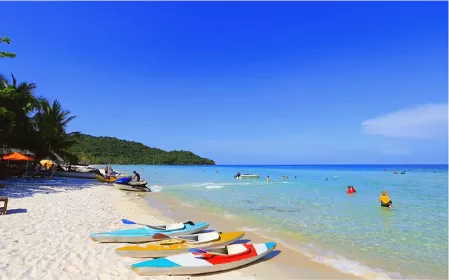If you are an individual who loves adventures and seeks to immerse yourself in pristine nature, you may have already encountered the term trekking. So, what exactly is trekking and why is it so widely chosen? Let’s explore the answers through the information summarized in the article below!
1. What is trekking? Trekking refers to an outdoor recreational activity or a form of camping where trekkers embark on lengthy hikes, often spanning several days, through suburban and rural landscapes, primarily in rugged mountainous terrains. This can be considered a form of extracurricular activity that is organized in open-air settings. Participants in trekking activities are commonly referred to as trekkers. Unlike other forms of traveling which primarily rely on motorbikes, trekking journeys embrace walking as a means to experience the surroundings. In other words, “Trekking signifies long-distance walking and represents an adventurous form of outdoor tourism in wild regions. The only means of transportation for a trekker is their own two feet.” The allure of trekking lies in the profound sense of freedom it provides participants. During a trekking excursion, individuals must eat, rest, and navigate at predetermined locations without assistance from other transportation modes. Consequently, to overcome challenges and survive in natural conditions, participants need to prepare an array of essential equipment.

2. Distinction between trekking and hiking Many people confuse trekking and hiking due to the similarities in these activities. So, what is hiking? Typically, hiking occurs on established routes like trails or paved roads, with many people having already traversed these terrains. In contrast, trekking often leads to entirely new and more challenging destinations with fewer prior explorers. The most significant difference between trekking and hiking lies in the intensity. Hiking requires fewer skills as the terrains are less treacherous, whereas trekking demands more skill due to potential hazards. Hikers often choose established paths and avoid ambiguous terrains, whereas trekkers may encounter rugged and challenging routes, necessitating a basic set of skills such as navigation and positioning. Furthermore, trekkers require specialized equipment to navigate difficult paths. To find their way, trekkers often utilize compasses, carry first aid kits, and possess survival skills acquired in advance of their journey. Depending on the specific activity, the items brought along may vary. Typically, trekking involves using more durable equipment. Regardless of the form, both activities demand a certain level of physical fitness and particular skills, especially courage from the participants.

*Additionally, here are some other travel terms:
– Climbing: The act of ascending steep terrains like mountains, which can take place both indoors and outdoors, on natural or man-made structures.
– Caving: The activity of exploring caves.
– Biking: The activity of cycling in groups across diverse terrains such as hills, mountains, and streams.
– Camping: The activity of setting up camp requires more preparation: tents, sleeping bags, sunscreen, mosquito repellent, food, medicine, etc.

3. What to bring for trekking? As mentioned earlier, trekking is an adventurous activity that poses considerable challenges. To ensure safety and the ability to survive in nature, it is crucial for participants to prepare adequately. Below are some essential items to bring when trekking:
3.1 Compass and map In the wilderness, filled with dense vegetation, it can be extremely difficult to determine directions, and getting lost in the woods can be perilous. Thus, a compass and a map are two indispensable items to have in your backpack to help you determine the appropriate course for your journey.

3.2 Trekking shoes Given that mountainous terrains are typically steep and slippery, preparing a quality pair of shoes that ensures waterproofing, features rubber soles coupled with spikes, will facilitate easier movement. Additionally, comfort is also paramount; wearing uncomfortable shoes on a long trek can lead to significant discomfort.

3.3 Medical supplies You cannot predict what health issues may arise during your journey. Incidents like falls, insect bites, or gastrointestinal issues are all possible during an adventurous outing. Therefore, do not forget to pack medical supplies to safeguard your health and that of your team.

3.4 Trekking knife Whether for cooking, chopping firewood, or clearing paths, a trekking knife is an essential tool. Ensure you choose high-quality knives that are sharp and compact for easy carrying and use when needed.

3.5 Bright flashlight for trekking Since trekking typically spans several days, overnight stays or nighttime movements in the wilderness are inevitable. Hence, never forget to pack a bright flashlight to aid visibility and observe your surroundings in the dark.
3.6 Outdoor backpack Long-distance trekking trips necessitate carrying numerous items. Thus, preparing a suitable outdoor backpack is essential. Ideally, select a backpack designed for comfort with a capacity to hold weights of 9-19 kg.

4. Important considerations when trekking To ensure safety and an enjoyable experience during your trekking adventure, take note of the following tips:
- It is advisable to hike as a team and maintain distance during the trekking journey to provide mutual support when needed.
- Never separate from the group, especially when crossing streams or gorges.
- When taking breaks, refrain from removing the backpack; instead, use it as a support.
- Avoid excessive water intake, as it can stimulate sweat glands and lead to dehydration.
- Apply mosquito repellent cream on any exposed skin to ensure health safety.
- When traversing the forest, make deliberate steps to prevent slipping and falling.
- Carve a piece of dry wood into a walking stick to enhance stability while moving.
- Set up camp while it is still light, ideally by 4 PM as darkness approaches.
- Choose a camping site near a water source and prepare enough firewood to maintain a large fire throughout the night for warmth and to deter wild animals.
I hope this article has shed light on what trekking is and the essential considerations when engaging in this exhilarating experience. If you are an adventure enthusiast, what are you waiting for? Prepare for an exciting trekking journey with your friends!







